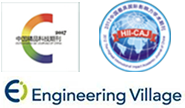Abstract:
In order to improve the photocatalytic performance of cuprous oxide (Cu
2O), Cu
2O particles and polyvinyl alcohol (PVA) were added to nanocellulose (CNF) at the same time, and a functionalized cellulose-based aerogel (Cu
2O-PVA/CNF) with three-dimensional (3D) porous structure and abundant active sites were successfully prepared by the exsitu method. The aerogel samples were characterized by scanning electron microscope, Fourier transform infrared spectroscopy, X-ray diffractometer, automatic specific surface area, and compression test. Taking the degradation of methylene blue (MB) as a model pollutant, the photocatalytic performance of 6wt%Cu
2O-PVA/CNF composite catalyst was evaluated, the effects of different initial concentrations, catalyst dosages and solution pH conditions on the photodegradation of MB were investigated. The results show that the use of the three-dimensional porous cellulose aerogel improves the adsorption capacity of MB and prolongs the absorption of visible light. In particular, Cu
2O doped in the cellulose matrix excites electron-holes under light, which increases the active sites, thereby improving the catalytic ability. The photodegradation rate of 6wt%Cu
2O-PVA/CNF composite catalyst to MB reaches 95.6%, which is much higher than 79.6% of pure Cu
2O. The photodegradation process of Cu
2O-PVA/CNF composite catalyst follows the apparent quasi-first order dynamics model. In addition, compared with pure CNF aerogel, the addition of PVA increases its compressive strength by 4.4 times. The catalyst is reused after 5 photocatalytic cycles, and the visible light catalytic degradation rate of MB can still reach 71.06%. The Cu
2O-PVA/CNF composite material is beneficial to the treatment of dye wastewater by solar radiation.


 下载:
下载: